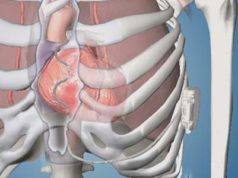
Researchers have developed a risk score to predict mortality for patients with atrial fibrillation (AF) who have undergone a successful transcatheter aortic valve implantation (TAVI) and have been discharged home.
The risk score is a product of the ENVISAGE-TAVI AF trial, which compared the safety and efficacy of the direct oral anticoagulant (DOAC) edoxaban with vitamin K antagonists (VKAs) in AF patients with an indication for oral anticoagulation after TAVI. George Dangas (The Zena and Michael A. Wiener Cardiovascular Institute at the Icahn School of Medicine at Mount Sinai, New York, USA) presented findings of the investigation as a late-breaking clinical trial at the European Society of Cardiology (ESC) 2022 congress (26–29 August, Barcelona, Spain).
“Our study focuses solely on high-risk TAVI patients with atrial fibrillation, which is a well-recognised surrogate of unfavourable prognosis,” said Dangas. “Although past research has been mostly focused on procedure risks, this new risk assessment tool focuses on how to stratify patients after completion of successful TAVI when they are ready for discharge, to improve outcomes.”
Approximately 33% of patients post-TAVI have prevalent or incident AF, Dangas noted in his presentation, commenting that AF is a well-established risk factor for mortality after the procedure. Surgeons often rely on the Society of Thoracic Surgeons (STS) risk score that was developed for open heart surgery, or other similar risk scores for this procedure, he added, pointing out that there is no well-established risk score for prognosis after successful completion of TAVI.
ENVISAGE-TAVI, which took place in 173 centres in 14 countries, compared the safety and efficacy of different therapies in AF/TAVI patients requiring oral anticoagulation. Researchers analysed 1,426 patients starting five to 12 days after TAVI and followed for up to one year to evaluate predictors of mortality.
Of the 178 patients (12.5%) who died within that timeframe, most were over age 64; had kidney disease and/or heart failure; higher weight; had non-paroxysmal AF; consumed more than three alcoholic drinks per day; and had a history of major bleeding or predisposition to bleeding during the procedure.
Investigators assigned a risk level to each of those predictors. Once they calculated total risk, they classified patients into three categories: low risk (between 0-10), moderate risk (between 11-15), and high risk (above 16). They validated the risk score and found that the mortality rate was more than double in the moderate-risk patients (10.1%) and triple in the high-risk group (17%) compared to the low-risk group (4.8%).
“We will continue to perform focused analyses on high-risk TAVI patients based on combinations of different/other clinical risks to enhance our understanding of patient risks after TAVI so we can then plan clinical investigations on improving prognosis,” said Dangas.









